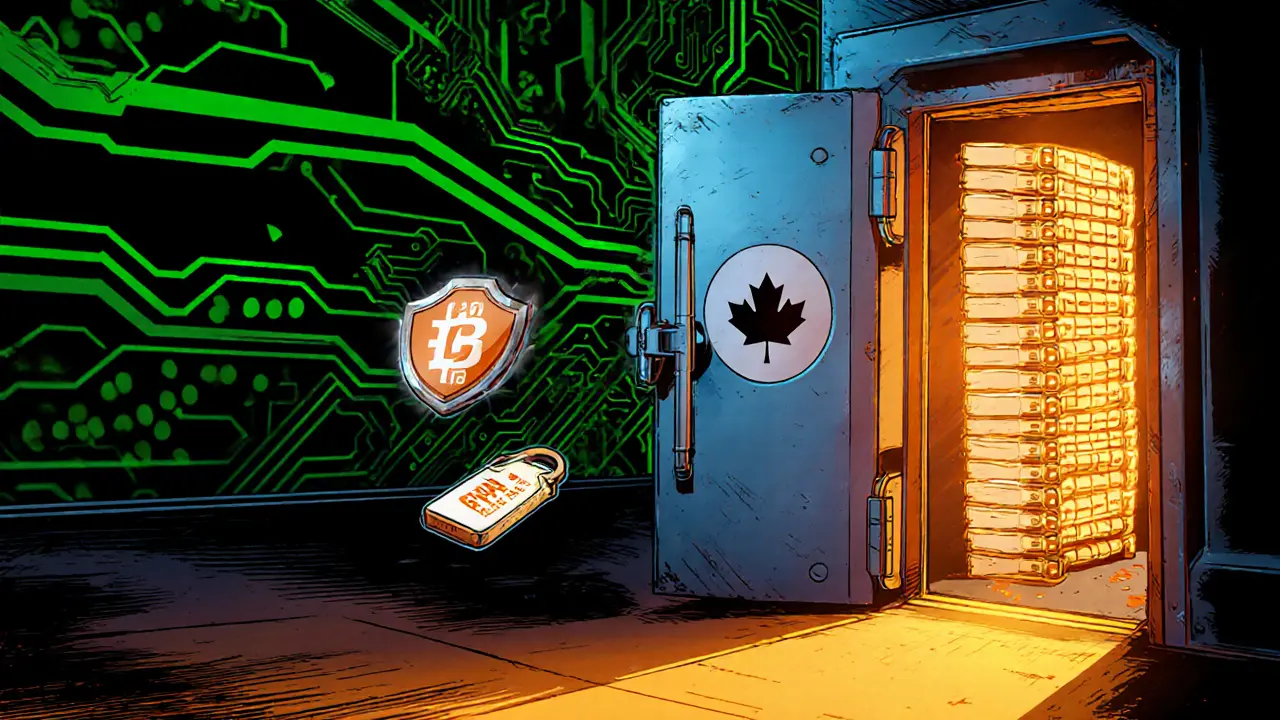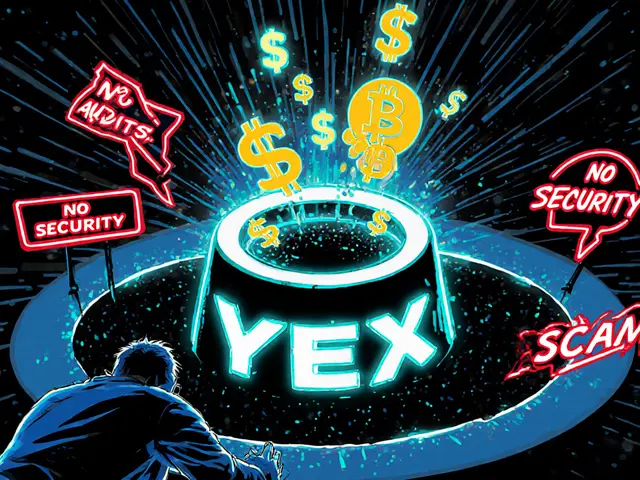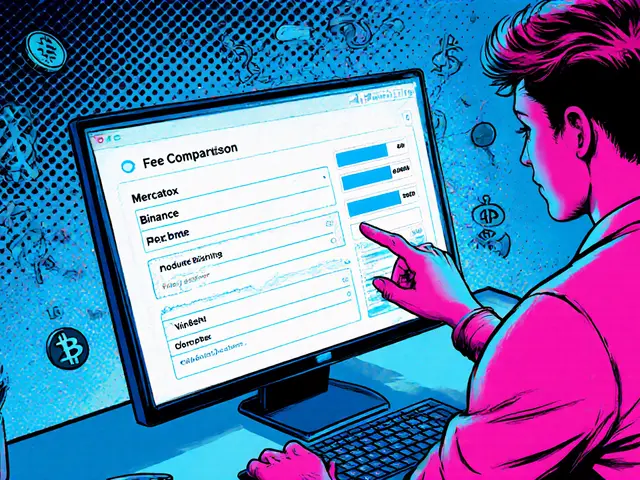Mercatox Fee Comparison Calculator
Fee Comparison Overview
This tool helps you understand how Mercatox's flat 0.25% fee compares with top exchanges. Enter your estimated monthly trading volume to see potential savings or costs.
Fee Comparison Results
About Mercatox Fees
Mercatox charges a flat 0.25% fee on all trades. While this is simple to calculate, it's higher than Binance's maker-taker model for high-volume traders. For small-scale traders, the difference is minimal.
If you’re hunting for a crypto exchange that’s been around for a decade, you’ve probably stumbled across Mercatox crypto exchange review. Mercatox bills itself as a “modern service for accessing e‑currency and cryptocurrency exchange markets,” promising a mix of trading, lending, and payment tools that should appeal to both newbies and seasoned traders. But does the platform live up to that hype? Below we break down the key parts: fees, security, liquidity, support, and how it stacks up against the heavyweights.
What Mercatox Actually Offers
Founded in Canada and launched in October 2015, Mercatox operates as a centralized exchange (CEX). Unlike niche spot‑only platforms, it bundles a multi‑currency wallet, a lending marketplace, and a payment gateway into a single web‑based interface that works on iOS, Android, Windows, macOS, and Linux. The platform’s proprietary trading engine lets you pick order types, tweak price alerts, and pull up a live order‑book window. For developers, a full‑featured API syncs with portfolio trackers like Koinly and a tax‑automation service that imports trades directly from exchanges, as well as analytics tools such as IntoTheBlock (on‑chain analytics and predictive indicators) and CoinLedger (crypto‑tax reporting).
Fee Structure - How Much Does Trading Cost?
Mercatox uses a flat‑rate model: 0.25% per trade, regardless of volume or whether you’re buying or selling. That lines up with the industry median, but it isn’t a “low‑fee” advantage when you compare it to makers‑takers or tiered‑discount models on exchanges like Binance, which can dip below 0.10% for high‑volume traders. For small‑scale users the difference is negligible, but heavy traders will notice the gap.
Security and Regulation - Is Your Money Safe?
The exchange is registered under Canadian law, which gives it a measure of financial oversight compared to completely unregulated offshore platforms. However, public filings on compliance are sparse, and Mercatox does not display a detailed audit report on its site. The platform stores the majority of user funds in cold wallets, reserving hot wallets for daily withdrawals. Two‑factor authentication (2FA) is mandatory for withdrawals, and IP‑whitelisting can be enabled for an extra layer of protection.
Liquidity and Trading Volume - Can You Execute Large Orders?
As of July 2025, Mercatox’s 24‑hour trading volume hovers around $35‑$40million, according to CoinMarketCap data. That’s a solid improvement from the $16million daily volume reported in 2019, but it’s still dwarfed by Binance’s $30billion and Coinbase’s $2billion daily turnover. Low liquidity can mean slippage on big orders, especially for less‑traded altcoins. If you’re a day trader who needs deep order books, Mercatox may feel a bit thin.
User Experience - What Do Real Users Say?
Mercatox markets a beginner‑friendly UI, and the web portal does look cleaner than many older exchanges. You can customize chart layouts, set quick‑trade buttons, and access a “training center” that offers webinars and written guides. On the downside, recent reviews on Reviews.io (a consumer‑review platform) highlight repeated withdrawal delays and account access hiccups. The average rating sits at 2.5/5, with complaints ranging from slow support response times to users needing third‑party fund‑recovery services. A handful of newer reviewers report smoother withdrawals after a manual account restoration, suggesting the platform may be gradually improving its support processes.

Customer Support - Help When You Need It
Support is advertised as 24/7 live chat, but community feedback indicates that live agents are often unavailable during peak hours, and ticket responses can take up to 48hours. The knowledge base is comprehensive, covering verification steps, API usage, and basic troubleshooting, but it lacks a searchable FAQ for common withdrawal issues-an oversight for a platform that has faced such problems.
How Mercatox Stacks Up Against the Big Players
| Feature | Mercatox | Binance | Coinbase |
|---|---|---|---|
| Founded | 2015 (Canada) | 2017 (Cayman Islands) | 2012 (USA) |
| 24‑hr Volume (USD) | ≈ $35M | ≈ $30B | ≈ $2B |
| Trading Fee | 0.25% flat | 0.10% maker / 0.12% taker (discounts up to 0.02%) | 0.50% flat (lower for Coinbase Pro) |
| Supported Assets | ≈ 250 coins/tokens | ≈ 1,200 coins/tokens | ≈ 600 coins/tokens |
| Withdrawal Speed | Hours to days (user reports mixed) | Minutes (most major chains) | Minutes to hours (depends on chain) |
| Regulatory Status | Canadian‑registered, limited public compliance info | Registered in multiple jurisdictions, often under scrutiny | US‑registered, strong compliance framework |
| Additional Services | Lending, payment gateway, multi‑currency wallet | Futures, staking, launchpad, NFT marketplace | Staking, Earn, Institutional services |
Pros and Cons - Quick Reference
- Pros:
- Over 10 years of continuous operation
- Flat‑rate fee is simple to understand
- Multi‑service ecosystem (trading, lending, payments)
- Comprehensive API and integrations with tax tools
- Cons:
- Liquidity lagging far behind top exchanges
- Mixed user reviews on withdrawals and support
- Fee competitiveness is only average
- Limited public transparency on regulatory compliance
Future Outlook - Where Is Mercatox Heading?
Mercatox has survived the boom‑and‑bust cycles that have taken down many mid‑tier exchanges, indicating a resilient operational backbone. The next few years will be crucial: to stay relevant, the platform needs to address its biggest pain points-withdrawal reliability and customer‑service efficiency. Adding higher‑frequency trading pairs, improving liquidity through market‑making partnerships, and publishing a clear compliance roadmap could help it capture a niche of users who want a multifunctional platform without the overwhelming feature set of Binance.
Key Takeaways
- Mercatox offers a solid, decade‑old exchange with a simple 0.25% flat fee.
- Liquidity and daily volume remain modest; expect some slippage on large trades.
- User feedback points to withdrawal delays and uneven support quality.
- Regulatory transparency is limited, though Canadian registration provides a basic safety net.
- For beginners seeking an all‑in‑one platform, Mercatox can work, but advanced traders may prefer larger, more liquid venues.
Frequently Asked Questions
Is Mercatox safe for storing large crypto balances?
Mercatox keeps most funds in cold storage, which is a standard security practice. However, the platform’s limited public audit information and mixed withdrawal experiences mean it’s wiser to keep only the amount you actively trade on the exchange and store the rest in a personal hardware wallet.
How does the 0.25% fee compare to other exchanges?
The fee is on par with many mid‑tier exchanges but higher than the maker‑taker models on Binance or the tiered discounts on Kraken. If you trade modest volumes, the flat fee is easy to calculate; high‑volume traders typically look for sub‑0.10% rates.
Can I use Mercatox’s API with tax software?
Yes. Mercatox provides full‑featured API endpoints that integrate directly with tax‑reporting tools like Koinly and CoinLedger. You can export trade history in CSV or JSON formats for easy import.
Does Mercatox support fiat deposits?
The exchange primarily focuses on crypto‑to‑crypto pairs. Fiat on‑ramps are limited and depend on regional payment partners. Canadian users can link bank accounts for CAD deposits, but the process is slower than dedicated fiat gateways on larger platforms.
What should I do if a withdrawal gets stuck?
First, check the withdrawal status in the “History” tab. If it shows “Pending,” open a support ticket with the transaction hash. Enable 2FA and, if possible, add your IP to the whitelist. Many users report that escalation to a senior support tier speeds up resolution.



Brooklyn O'Neill
January 12, 2025 AT 11:38Mercatox seems solid for newcomers, its flat fee makes budgeting easy.
Ciaran Byrne
January 18, 2025 AT 21:48Liquidity is modest, so large orders may slip.
Patrick MANCLIÈRE
January 25, 2025 AT 07:58One thing I like about Mercatox is the integrated API – you can pull balance, trade history, and even automate lending without juggling multiple keys.
It also supports a decent range of about 250 tokens, which covers most of the popular projects.
If you’re a beginner, the UI is clean enough to not feel overwhelmed, yet advanced traders still get the order‑book depth view.
Just keep an eye on the volume; the order book can be thin on some altcoins.
Carthach Ó Maonaigh
January 31, 2025 AT 18:08Yo, Mercatox is that middle‑child of exchanges – not as flashy as Binance, not as busted as some sketchy platforms.
The fees sit smack in the middle, and the withdrawal delays sometimes feel like waiting for a snail to finish a marathon.
Still, if you don’t need lightning‑fast exits, it’s a decent playground.
Marie-Pier Horth
February 7, 2025 AT 04:18Ah, the tragedy of high fees! A dramatic sigh for every trader.
Gregg Woodhouse
February 13, 2025 AT 14:28Withdrawals can be a nightmare.
F Yong
February 20, 2025 AT 00:38Sure, because trusting a platform with delayed payouts is everyone's dream.
Sara Jane Breault
February 26, 2025 AT 10:48I've been using Mercatox for a few months and the learning curve is gentle.
The training centre tutorials helped me get past the basics quickly, and the support staff finally responded when I followed up on a stuck withdrawal.
It’s not perfect, but for a hobbyist it does the job.
Darius Needham
March 4, 2025 AT 20:58How does the API handle pagination for large trade histories? I often need to back‑fill months of data for tax reporting.
WILMAR MURIEL
March 11, 2025 AT 07:08Reading through Mercatox's review reminded me how complex the exchange landscape has become, and it sparked a cascade of thoughts about where new users really belong.
First, the flat 0.25% fee is simple enough for someone just dipping their toes into crypto, avoiding the confusion of maker‑taker tiers that can be bewildering for novices.
Second, the platform’s longevity-operating since 2015-does lend a certain gravitas; it has survived the boom‑and‑bust cycles that wiped out many competitors, suggesting an underlying robustness.
Third, the security model is fairly standard: most funds in cold storage, mandatory 2FA, and optional IP whitelisting, which together form a respectable barrier against common threats.
However, the lack of a publicly available audit report does leave a gap for the risk‑averse, who often demand full transparency.
Liquidity, though improving, still lags far behind the giants; a $1 million order on a thin altcoin could see significant slippage, which is a deal‑breaker for high‑frequency traders.
The user experience feels polished; the UI is cleaner than many legacy exchanges, and the customizable chart layouts are a nice touch for those who like to tinker.
Support, on the other hand, appears to be the Achilles' heel: reports of delayed responses and withdrawal hiccups suggest the support team may be understaffed or overwhelmed during peak periods.
Some community members note that after escalating to senior staff, issues resolved faster, hinting at a tiered support system that isn’t clearly communicated.
When comparing to Binance or Coinbase, Mercatox's fee advantage evaporates for high‑volume traders who can benefit from sub‑0.10% rates on Binance's maker‑taker model.
Conversely, for small‑scale investors, the fee differential is negligible, making Mercatox a viable, all‑in‑one option.
Additionally, the integration with tax tools like Koinly and CoinLedger is a practical benefit, streamlining the often tedious tax filing process.
Overall, the platform occupies a niche: a solid, moderately secure, user‑friendly exchange that still has work to do on liquidity and support.
For beginners or those who value an uncomplicated fee structure, Mercatox can be a good fit.
Advanced traders, however, may find the limited order book depth and slower customer service a deterrent.
carol williams
March 17, 2025 AT 17:18While I appreciate the thoroughness of the preceding analysis, I must emphasize that the platform's regulatory posture remains somewhat opaque.
Without a detailed compliance dossier, prudent investors should conduct independent due diligence before allocating substantial capital.
Ally Woods
March 24, 2025 AT 03:28Not a fan of the slow withdrawals, but the UI is decent.
Kristen Rws
March 30, 2025 AT 13:38i thnik th eui is ok but could b bettr.
Fionnbharr Davies
April 5, 2025 AT 23:48The community vibe feels inclusive, and the educational resources are genuinely helpful.
Even if some features lag behind the big players, the platform still offers a solid entry point for newcomers.
Narender Kumar
April 12, 2025 AT 09:58In summation, the exchange presents a respectable offering amidst a saturated market.
Andrew McDonald
April 18, 2025 AT 20:08While I respect the platform's ambition, I remain skeptical about its scalability. 🙂
Nilesh Parghi
April 25, 2025 AT 06:18The cultural impact of exchanges like Mercatox illustrates how finance is becoming truly global.
It's fascinating to see a Canadian‑registered service competing on a worldwide stage.
Keith Cotterill
May 1, 2025 AT 16:28Indeed, the platform's strategic positioning within a niche market underscores its potential for incremental growth; nevertheless, one must critically assess the liquidity constraints that may impede large‑scale arbitrage opportunities.
C Brown
May 8, 2025 AT 02:38Great, another exchange that promises everything but delivers a snail‑paced withdrawal service.
Noel Lees
May 14, 2025 AT 12:48Stay positive! Even a slow withdrawal can be a learning moment. 😎
Raphael Tomasetti
May 20, 2025 AT 22:58Mercatox offers a decent API endpoint for real‑time market data, which is handy for traders integrating custom bots.
Jenny Simpson
May 27, 2025 AT 09:08Sure, let's all ignore the glaring liquidity issues and pretend everything's perfect – classic optimism.
Sabrina Qureshi
June 2, 2025 AT 19:18Wow!!! The platform's interface is so user‑friendly!!! I love it!!!
Rahul Dixit
June 9, 2025 AT 05:28Honestly, the whole crypto exchange ecosystem is a front for larger financial institutions to test surveillance techniques on unsuspecting users. Stay alert.